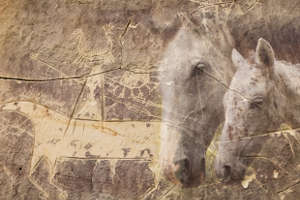Using AI to control energy for indoor agriculture
30 September 2024
Published online 6 April 2023
Archaeological and scientific analyses of horse remains confirm Indigenous oral histories about the domestication of horses in North America’s Great Plains.

Composite graphics design: Daniel Deering. Left: Pat Doak. Right: © Sacred Way Sanctuary.
Until recently, horses were thought to have been introduced to North America by European colonisers. Now, an international study, including three researchers in Saudi Arabia – and in partnership with Indigenous representatives and historians – has used archaeological, genetic, radioisotopic and other scientific data to show that horses were already part of Indigenous life before Europeans arrived in the 17th century.
Researchers examined 33 horse specimens and found three that pre-dated the Pueblo Revolt – the 1680 uprising of Indigenous tribes against Spanish invaders in New Mexico.
“Some of those horses were integrated into Indigenous ceremonies, like one was buried alongside three coyotes,” says University of Colorado Boulder anthropologist and study lead author, William Taylor. Another horse had received veterinary care to mend a facial fracture. There were also indications that the horses had been ridden, such as tiny fractures in the spines from the impact of a rider, and wear on the back teeth from a bit.
Combining all their evidence, the authors suggest that horses were first adopted into Indigenous culture and life between 1516 and 1599, well before the arrival of Europeans.
“We have a pretty compelling purely empirical story here, not just that the horses spread north, but that they were already, by the early 1600s, deeply integrated into native societies across the West,” Taylor says.
“The lovely thing about it is that it comes full circle, and the science goes along with what oral tradition has always said,” adds study co-author and tribal historian of the Comanche Nation in Austin, Texas, Jimmy Arterberry.
Ross MacPhee, senior curator in the Division of Vertebrate Zoology at the American Museum of Natural History, New York, who wasn’t involved in the study, says it is a landmark in its collaboration between scientists and Indigenous people, and challenges the prevailing notion that Europeans introduced horses to North American Indigenous cultures.
“It explains the long-term involvement of Indigenous people and how that affected their perception of horses and their place in nature,” MacPhee says.
doi:10.1038/nmiddleeast.2023.27
Taylor, W. et al. Early dispersal of domestic horses into the Great Plains and northern Rockies. Science 379,6639 1316–1323 (2023).
Stay connected: